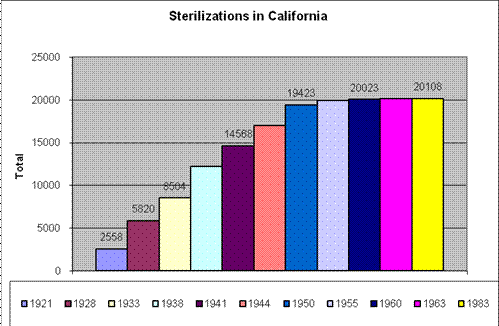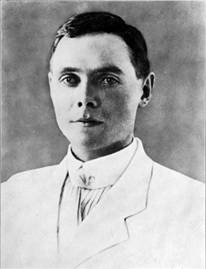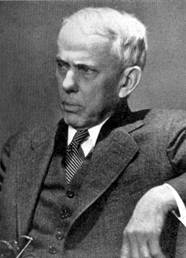California
Number of Victims
In total, 20,108 people
were sterilized in the state of California prior to 1964. California
had by far
the highest number of sterilizations in the United States (one third of
all
sterilizations nationwide). The numbers of men and women sterilized
were about
equal. Of
the total sterilizations, almost
60% were considered mentally ill and more than 35% were considered
mentally
deficient.
Men and women of Mexican origin
represented between 7% and 8% of those sterilized (Stern, Eugenic
Nation,
p. 111). African Americans made up 1% of California’s population but
accounted
for 4% of the sterilizations (Stern, Eugenic Nation,
p. 111).
Period during which sterilizations occurred
The first sterilization law was
passed in 1909. From here,
sterilizations occurred at a steady increasing rate until about 1950. Prior to 1921, there were
2,558 sterilizations
and this rate continued to increase until around 1950.
After 1950, the rate slowed, and only 85
sterilizations occurred after 1960. All recorded sterilizations appear
to have occurred
prior, but there is some evidence to
support the claim that sterilizations may have been
performed into the 1970s, through deception of patients and their
guardians (see
Stern, “Sterilized”).
Temporal Pattern of sterilizations and rate of sterilization

Sterilization rates started off
fairly low with 12 sterilizations
per year in the first 12 years after the passage of the 1909 law. However, after 1921, the
rate soared to about
450 per year, or about 13 sterilizations per 100,000 residents per
year. This
rate held fairly constant until about 1950, when it began to level off.
After this,
sterilizations became fairly rare
and did not happen with as much frequency. The last sterilization
occurred in
1963.
Passage of Laws
The first
state sterilization law in
A second law was passed on June 13, 1913. This law repealed the first law and established different guidelines. (Laughlin, p. 2). It allowed for a wider range of people to be sterilized. Anyone who was “afflicted with hereditary insanity or incurable chronic mania or dementia” (Braslow, pp. 33-34) could be sterilized. This law also established the State Lunacy Commission, which had the power to order sterilizations. However, this law did call for parental consent in the case of the sterilization of minors (Braslow, p. 34).
The third law, enacted at the end of July, 1917,
created modifications to the 1913 sterilization law by expanding the
scope of
who could be sterilized (Kline, p. 50).
Two amendments were made to the 1913 law which included
specific
references to the Sonoma State Home and the Pacific Colony. (Laughlin,
pp. 3, 7, 8).
The law established the Pacific Colony and allowed the Board of
Trustees of
this institution to grant permission for sterilizations of those living
there
(Gottshall).
In both 1935 and 1937, legislation was drafted
that would have established a State Eugenics Board and further expanded
the
state's authority to perform sterilizations to include inmates and
residents of
behavioral and other non-mental reformatory institutions. However, the bills failed
and never became
law (Stern, Eugenic Nation,
p. 83)
In
1951,
the laws were amended to require full authorization from the patient in
order
to perform sterilizations, and statements made by the Department of
Mental
Hygiene, and others, throughout the 1950s further affirmed the
psychiatric
movement away from sterilization. (Paul p. 267) These laws, combined,
allowed
eugenic sterilizations to occur in the state of California through
1964.
(Gottshall).
In 1927, in an 8-to-1 decision, the United
States Supreme Court upheld the constitutionality of
Groups identified in the Law
The 1909 law was aimed specifically at those in
prisons and with mental
disabilities that caused them to be institutionalized.
Of those with mental disabilities, the law
targeted patients in state hospitals and institutions of the
feeble-minded. In
terms of the
prisoners, the law targeted those who were inmates for life, showing
“sex or
moral perversions”, or were certain repeat offenders (Gottshall;
Laughlin, p.
7). The
1913 law expanded to target all inmates in state hospitals or homes
for the feeble-minded (except voluntary patients in state hospitals),
as well
as all repeat offenders in state prisons (Laughlin, p.7). The 1917
amendments
greatly expanded the groups targeted even further to include those who
had
hereditary mental diseases, “those suffering from perversion or marked
departures from normal mentality”, and those with sexually-transmitted
diseases
(Laughlin, pp.7-8). These two later laws expanded to include virtually
any
individual deemed unfit. Out
of those
sterilized, 70% were labeled as mentally ill (Paul, p. 261).
Process of the Law
In
1909, in order to
legally sterilize someone, the
approval of any two of the three following individuals was required:
the
superintendent or resident physician of the institution, the
superintendent of
state hospitals, and the secretary of the State Board of Health
(Gottshall). If these approvals were
given, sterilization
could occur (Gottshall). In 1913, the jurisdiction over sterilization
in California Butler
Precipitating Factors and Processes
Around the turn of the century, increased immigration of Chinese and Mexicans lead to changes in California’s demographics (Stern, Eugenic Nation, pp. 57-59). Especially important was the influx of Mexicans looking for work. Their presence cost the state a lot of money in charity and welfare. This began a process of trying to keep the undesirable Mexicans out of the United States (Stern, Eugenic Nation, pp. 57-59). As a result, progressives began to look for a way to easily eliminate degeneracy and disorder in the new chaos (Gottshall). European settlers sought to establish a community, based on modern science, which fulfilled the Manifest Destiny and downplayed the Spanish and Mexican past of the territory (Stern, Eugenic Nation, p. 85). Furthermore, African-American men were seen as being excessively virile and this needed to be controlled to protect women (Kline, p. 9). Similarly, the idea of “race suicide” emerged on a national level. This concept stated that women of good stock should be having children in order to ensure that the white middle class not be taken over by inferiors (Kline, p. 11).
The changing economy led to changing gender roles in society. As the economy became more corporate, white men were becoming perceived as less masculine due to the desk jobs they often occupied (Kline, p. 9). At the same time more and more women began to work outside of the home. These women were seen as overly sexual and challenging to the traditional roles of middle class women (Kline, pp. 10-11). Many doctors were concerned with women giving birth out of wedlock. This caused doctors to sterilize some women in order to prevent this from happening (Braslow ,p. 47). Progressive Era reformers saw these changes and began to implement eugenic programs to help “better” society (Stern, “Sterilized,” p. 1129).
The driving force behind the statutes regarding
sterilization in
Groups Targeted and Victimized
The most commonly targeted groups were those with mental illnesses. These included alcoholics, epileptics, individuals with Down’s syndrome, the insane, and those who were manically depressed (Gottshall). The range of those targeted was expanded as the result of the laws over the years. These individuals were disproportionately female and racial minorities. Women who were seen as sexually promiscuous were often sterilized as a “cure” for their actions (Kline). Mexicans and African Americans were also disproportionately sterilized (Stern, Eugenic Nation, p. 111). Inmates in prisons, especially those whose crimes were sexual in nature, were targeted in the early years of the program. Later, the focus shifted primarily to target those with mental illnesses (Gottshall).
However, in practice, the law was also applied to many others, ranging
from alcoholics to paupers to people infected with syphilis (Center for Science, History, Policy, and
Ethics, see Senate Resolution
No. 20).
Of those the Sonoma
State Home sterilized through June
30, 1916, about half were characterized as “manic depressive”, with
another
third characterized as either having “dementia praecox” or being
epileptic
(Laughlin, p.53). In
addition, rather
than sterilize them, the Sonoma State Home participated in a program to
deport
“mentally defective” immigrants—at a rate of about 37 immigrants per
year, with
about half being Mexican or Filipino (Kline, p.59).
Other Restrictions placed on those identified in the law or with disabilities in general
Many of those who were released went
on to live relatively
normal lives. They were married, and although without children, were
able to
support themselves (
Major Proponents
 (Photo origin: Wikipedia.com; available at http://en.wikipedia.org/wiki/Paul_Popenoe)
(Photo origin: Wikipedia.com; available at http://en.wikipedia.org/wiki/Paul_Popenoe)
Paul Popenoe was raised in California and studied Biology. As a journalist, he wrote columns promoting eugenics. He believed that charity was the reason society had so many degenerates that had survived for so long. He conducted extensive research about I.Q.’s and the individuals who had been sterilized in order to promote the cause (Stern, Eugenic Nation, pp. 105-107). Working with E.S. Gosney, he researched California’s eugenic institutions and helped promote the program (Braslow, p. 41). Although he continued to work on Eugenics for the rest of his life, he eventually had to denounce negative eugenics as it fell out of favor in the 1940s (Stern Eugenic Nation, p. 106).
 (Phote origin: Wikipedia.com; available at http://en.wikipedia.org/wiki/
(Phote origin: Wikipedia.com; available at http://en.wikipedia.org/wiki/
E.S. Gosney was a philanthropist who
helped to finance and
promote the eugenics program (Popenoe). He worked along with Popenoe to
collect
data about sterilizations by researching California’s state
institutions. He
helped fund and create the Human Betterment
Society for well-known wealthy individuals who supported eugenics.
Unlike many
eugenic supporters of the day, his focus was primarily on the benefits
for
society, not the benefits for the individual (Braslow, p. 41).
F.O. Butler was the superintendent of Sonoma State home starting in 1918. He believed that sterilization benefited both the individuals and society as a whole (Butler). Both through public promotion and actual operations, he was largely responsible for thousands of sterilizations. He himself is estimated to have performed at least 1000 sterilizations throughout his career (Kline, p. 52).
Charles M. Goethe was a businessman from Sacramento who promoted eugenics in the San Francisco area (Stern, “Sterilized” p. 1129). He advocated for eugenic policy including immigration restriction, “better breeding”, and sterilization. With a background in plants and animals, he viewed eugenics as a way of improving the human race (Center for Science, History, Policy, and Ethics).
Frederick W. Hatch, Jr. was the secretary of the State Lunacy Commission in California. After the sterilization law was passed in 1909, he became the General Superintendent of State Hospitals. He held this position for the rest of his life, using it to implement policy and hire hospital administrators in favor of eugenics. While he held this position, about 3,000 people were sterilized in California (Gottshall). Even after his death in 1924, his legacy of an active program for sterilization lived on through the next hospital superintendents.
Ulysses
S. Webb was the attorney general
of California during much of the Progressive Era, holding that position
for 37
years. He was confident that eugenic sterilization laws, especially
those requiring
some form of consent, would survive a challenge by the courts. He
preferred
that sterilizations be used as a medical treatment, rather than as a
punishment
by the courts. (Gottshall)
“Feeder Institutions” and institutions where sterilizations were performed
 (Photo origin: Alex Wellerstein; available at http://www.people.fas.harvard.edu/~wellerst/collection/)
(Photo origin: Alex Wellerstein; available at http://www.people.fas.harvard.edu/~wellerst/collection/)
The Sonoma State Home was a state hospital founded in 1884 designed to help educate mentally disabled children. Many of these children were those who got into trouble at home (Kline, p. 34). With the advent of eugenics, the home began to grow in size and prestige. So as not to be a burden to the public, Sonoma was self sufficient by having the residents grow gardens and take care of themselves and each other (Kline, p. 36). As time passed, it soon became the central area for sterilization with less emphasis on helping the patients (Kline, p. 37). It was especially focused on sterilizing women who were considered sexually deviant. Many of these women were considered such because they had sex outside of marriage (Kline, pp. 55-57). Still open today, renamed the Sonoma Development Center, there is no mention of the past on the website (State of California).
The Pacific Colony was an institution
that was created under
the 1917 sterilization law and it dealt
with the sterilization of epileptics and mentally delayed individuals. This was created as a
result of the apparent
growing number of “feeble-minded” individuals.
On
By 1921, in addition to the Sonoma State home, several state hospitals performed sterilizations of some kind. These included the state hospitals in Stockton, Napa, Agnews, and Norwalk; the Mendocino State Hospital in Talmage and the Southern California State Hospital in Patton. In total, there were 3, 939 sterilizations performed at the six state hospitals (Barslow, p. 35).
 (Photo origin: Alex Wellerstein; available at http://www.people.fas.harvard.edu/~wellerst/collection/)
(Photo origin: Alex Wellerstein; available at http://www.people.fas.harvard.edu/~wellerst/collection/)
The California State Hospital at Stockton performed the largest amount of sterilizations out of the six state hospitals. Prior to June 1926, physicians at Stockton had performed over ten times as many sterilizations as at Agnews State Hospital, accounting for almost 40% of the total amount performed up to this date (Barslow, p. 36). The large-scale sterilization at Stockton was made possible because the physicians at Stockton believed in the medical value of sterilization and demonstrated this conviction in their work. Even though these doctors did have hereditarian beliefs, these were not the ones that guided their decision to operate. They genuinely believed that patients that had undergone sterilization showed “marked improvement” (Barslow, p. 38). Rather than seeing sterilization as a way to prevent the degeneration of the human stock, these physicians saw the surgery as an intervention aimed at improving the individual’s life. The belief in therapeutic benefits allowed for male sterilization prior to the 1930s to escalate. Doctors believed that the patients felt mentally and physically stronger after the surgery. Although this belief waned by the mid-1930s, it made it possible for more sterilizations to occur. In addition, patients shared the belief that sterilization was therapeutic, making it easier to perform the operation (Barslow, p. 44). This belief was also demonstrated in the sterilization of women. Sterilization of women was guided by the belief that they were protected from psychological and social strains of childbirth and motherhood (Barslow, p. 46). This is what made Stockton unique. At Stockton, sterilization functioned as a alleged solution to a patient’s individual problems on a large scale (Barslow, p. 51). The Stockton State Hospital closed in 1996 and its ground is now part of the Stockton campus of California State University, Stanislaus.
Finally, state prisons in California
also participated in
the sterilization of individuals, although on a much smaller scale. San Quenton and Folsom
Prisons conducted some
sterilization on inmates who were convicted of crimes of a sexual
nature
(Gottshall). The Folsom State
Prison and the Preston School of Industry in Waterman began performing
sterilizations as of January 1, 1921 (Laughlin, p. 52).
Opposition
Proponents of sterilizations met very little opposition to their ideas. They marketed it as good for society and the individuals sterilized. Towards the later part of the eugenics movement, activist groups began protesting the injustices committed against their members. These included both African Americans and Mexicans in the 1950s and 1960s (Stern, “Sterilized,” p. 1134). There were also two court cases that challenged the sterilization law. The first of these was the Hewitt case in which a young woman was sterilized against her will but with the consent of her mother. However the case was not brought to trial (Paul, p. 262). The second case, known as the Garcia case, involved a petition to end the enforcement of the sterilization law. This case was also not heard because it supposedly lacked any facts justifying a hearing (Paul, pp. 265-266).
Commemoration
In
the fall of 2005, California’s
first ever exhibition of the state’s eugenic history was run for four
weeks at
the Library Gallery at California State University Sacramento. The exhibit was called
“Human Plants, Human
Harvest: The Hidden History of California Eugenics.” The public is
unaware of
this history and there was no common background or knowledge on the
subject
upon which to build an exhibition. Therefore, the exhibit took the
visitors
through a series of seven sections of visual chapters of flat
wall-pieces that
were mounted in between two huge sheets of Plexiglas. The exhibit
utilized high-quality
reproductions of historical photographs and documents (Brave and Sylva,
p. 38). These
images, although they spark interest,
had to be used carefully because they range from “ludicrous to
loathsome” and
therefore had the potential to be viewed as illegitimate pieces of
information
(Brave and Sylva, p. 39). Since
the
images served as the major carriers of information to the visitors, it
was
necessary to secure the visitors’ trust that this history did actually
happen.
This
exhibit was created for
several reasons. One
is that the
eugenics movement has been underrepresented in visual media, while
there has
been many books published and read on the issue.
As a visual culture, a visual representation
is necessary in order to reach the public. It was also created because
people
were concerned that California’s history of eugenics would remain
unknown. However,
some resisted the uncovering of this
information because they saw the exhibit as being perceived as more
“feel-bad”
than “feel-good” (Brave and Sylva, p. 42). Overall, however, many
visitors viewed
the exhibit as both eye-opening and shocking, as “powerful and
beautiful in its
truth telling” (Brave and Sylva, p. 43). There is no memorial for the
20,108
people sterilized in California, and other than a governor’s apologies
for the
past, this is the first public commemoration of California’s eugenic
past.
Bibliography
Braslow, Joel T.. 1996. "In the Name of Therapeutics: The
Practice of
Sterilization in a
Brave, Ralph, and Kathryn Sylva.
2007. “Exhibiting Eugenics: Response and Resistance to a Hidden
History.” The Public Historian 29,
3: 33–51.
Center for Science, History,
Policy,
and Ethics. 2005. "Eugenics in
Gottshall, Jon. 1995. "The
Cutting Edge: Sterilization and Eugenics in
Kline, Wendy. 2001. "From
Segregation to Sterilization: Changing Approaches to the Problem of
Female
Sexuality." Building a Better Race: Gender, Sexuality, and
Eugenics
from the Turn of the Century to the Baby Boom.
Laughlin, Harry H.
1922. Eugenical Sterilization in the United
States. Chicago: Municipal
Court of Chicago.
Paul, Julius. 1965.
“‘Three Generations of
Imbeciles Are Enough’”: State Eugenic Sterilization Laws in American
Thought
and Practice.” Unpublished manuscript.
Popenoe, Paul. 1928. "Eugenic
Sterilization in
State of California. Department of
Developmental Services. “Sonoma Developmental Center.” Available at
<http://www.dds.ca.gov/Sonoma/Index.cfm>.
Stern, Alexandra Minna. 2005a. Eugenic
Nation: Faults and Frontiers of Better Breeding in Modern
Stern, Alexandra Minna. 2005b.
“Sterilized in the Name of Public Health: Race, Immigration, and
Reproductive
Control in Modern